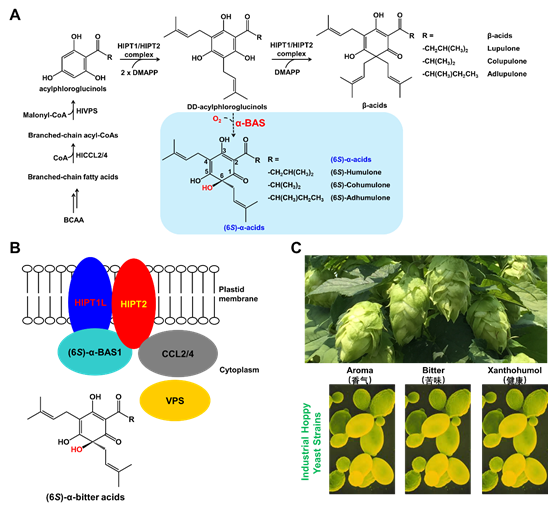Hops are an essential ingredient in beer brewing and an important economic crop. The female flowers of hops are covered with tiny glandular trichomes that synthesize and store a wide variety of specialized metabolites, which together define the flavor and quality of beer. Terpenes provide the distinctive aroma, xanthohumol contributes potent antioxidant activity that benefits human health, and α-bitter acids are responsible for beer’s characteristic bitterness. Historically, these compounds also served as natural preservatives, extending beer’s shelf life long before modern brewing technologies emerged. While the upstream biosynthetic pathway of α-bitter acids has long been clarified, the enzyme responsible for the final step, α-bitter acid synthase (α-BAS), had remained functionally unverified for over a decade, despite the identification of several candidate genes.
To solve this long-standing mystery, a research team led by Professor WANG Guodong at the Institute of Genetics and Developmental Biology, Chinese Academy of Sciences, developed a highly sensitive LC–MS detection method capable of distinguishing between the two chiral forms of α-bitter acids (6S and 6R). Their analysis revealed that hop glandular trichomes mainly accumulate the 6S-type α-bitter acid.
Further investigation showed that its precursor, deoxy–α-bitter acid, easily undergoes auto-oxidation when exposed to air, forming a racemic mixture of 6S- and 6R-types. This spontaneous chemical reaction had long hindered efforts to confirm the true function of α-bitter acid synthase. By overcoming this technical challenge, the team established a yeast heterologous expression system to systematically test more than ten candidate genes.
The results pinpointed HlMO18 as the enzyme that specifically catalyzes the oxidation of deoxy–α-bitter acid to produce predominantly the 6S form. The researchers also identified key amino acid residues crucial for the enzyme’s activity. Further mechanistic analyses revealed that the 6S-type α-bitter acid synthase forms a metabolic complex with upstream enzymes, explaining why only the 6S form accumulates in hop glandular trichomes.
This work completes the biosynthetic map of α-bitter acids in hops and provides valuable insights for the brewing industry. The team has now elucidated the biosynthetic pathways of the three major flavor compounds in hops.
Looking ahead, they plan to use synthetic biology to engineer industrial yeast strains capable of producing “hoppy beer”, beer with authentic hop flavors but without using hop plants. This approach could lower production costs and enable more customized, flavor-rich beers, offering a fresh direction for innovation in the brewing industry.
The study was recently published in Plant Communications ( DOI:10.1016/j.xplc.2025.101528).
Figure. In hop glandular trichomes, a flavin-dependent monooxygenase (α-BAS) catalyzes the final step in the biosynthesis of 6S-α-bitter acid (Image by IGDB).
A. Simplified biosynthetic pathway of α-bitter acids; B. Enzymes catalyzing the formation of 6S-α-bitter acid assemble into a protein complex; C. Future “Hoppy Yeast” strains used for producing “hoppy beer” with various flavor combinations.
Contact:
Professor WANG Guodong
Institute of Genetics and Developmental Biology, Chinese Academy of Sciences
Email: gdwang@genetics.ac.cn
 Figure. In hop glandular trichomes, a flavin-dependent monooxygenase (α-BAS) catalyzes the final step in the biosynthesis of 6S-α-bitter acid (Image by IGDB).A. Simplified biosynthetic pathway of α-bitter acids; B. Enzymes catalyzing the formation of 6S-α-bitter acid assemble into a protein complex; C. Future “Hoppy Yeast” strains used for producing “hoppy beer” with various flavor combinations.Contact:Professor WANG GuodongInstitute of Genetics and Developmental Biology, Chinese Academy of SciencesEmail: gdwang@genetics.ac.cn
Figure. In hop glandular trichomes, a flavin-dependent monooxygenase (α-BAS) catalyzes the final step in the biosynthesis of 6S-α-bitter acid (Image by IGDB).A. Simplified biosynthetic pathway of α-bitter acids; B. Enzymes catalyzing the formation of 6S-α-bitter acid assemble into a protein complex; C. Future “Hoppy Yeast” strains used for producing “hoppy beer” with various flavor combinations.Contact:Professor WANG GuodongInstitute of Genetics and Developmental Biology, Chinese Academy of SciencesEmail: gdwang@genetics.ac.cn CAS
CAS
 中文
中文




.png)
